Common menu bar links
Breadcrumb Trail
ARCHIVED - Department of Finance - Report
 This page has been archived.
This page has been archived.
Archived Content
Information identified as archived on the Web is for reference, research or recordkeeping purposes. It has not been altered or updated after the date of archiving. Web pages that are archived on the Web are not subject to the Government of Canada Web Standards. As per the Communications Policy of the Government of Canada, you can request alternate formats on the "Contact Us" page.
Minister's Message

I am pleased to present the 2010–11 Departmental Performance Report, which highlights the Department of Finance Canada's actions over the past year to improve Canada's long-term economic prospects and to address the many challenges that remain following the global economic crisis.
In 2010–11, the Department supported the implementation of year two of Canada's Economic Action Plan. It did this by monitoring, assessing and reporting on overall Economic Action Plan progress, as well as by directly overseeing the Extraordinary Financing Framework to improve access to financing for Canadian households and businesses. In addition to providing sound fiscal management, the Department helped ensure the responsible use of tax dollars by assisting the government in undertaking a comprehensive review of federal operating and program expenditures and by supporting the government's plan to eliminate the deficit and return to balanced budgets. In its efforts to contribute to Canada's recovery, the Department developed and implemented policies and programs that improved Canadian productivity, for example, reducing red tape for businesses through initiatives such as creating a tariff-free zone for manufacturers, and attracting venture capital by eliminating the need for tax reporting for many investments. In 2010–11, the Department also took measures to promote fair business practices by introducing a Code of Conduct for the Credit and Debit Card Industry in Canada, and to protect Canadian consumers through credit card regulations and adjustments to the rules on government-backed insured mortgages.
Throughout 2010–11, the Department continued to play a central role in programs supporting provincial and territorial governments. This included the administration of transfer payments to provinces and territories, which brought the total federal support to the highest level ever. In 2010, the Department reached an agreement with the provinces and territories on a framework for the introduction of a new kind of pension plan, called the Pooled Registered Pension Plan. The Department is working with the provinces and territories and consulting with the private sector to create these private sector pension plans to improve access to pensions for working Canadians.
With Canada as chair of the G7 process in 2010 and chair of the G20 Leaders' Summit in Toronto in June 2010, the Department played a key role in developing the international economic agenda. During 2010–11, the Department worked with other G20 countries to address the causes of the international financial crisis and to determine the actions needed to stabilize financial markets and reform the global financial system.
While the Canadian economic recovery strengthened through 2010–11, the global economy remains fragile. As a result, the Department will continue to support the government's transition from providing temporary support to protect jobs and output, to balancing the federal budget and creating the right conditions for sustainable long-term growth that will benefit all Canadians as outlined in The Next Phase of Canada's Economic Action Plan: A Low-Tax Plan for Jobs and Growth.
Section I: Departmental Overview
Raison d'�tre
The Department of Finance Canada is committed to making a difference for Canadians by helping the Government of Canada develop and implement strong and sustainable economic, fiscal, tax, social, security, international and financial sector policies and programs. It plays an important role in ensuring that government spending is focused on results and delivers value for taxpayer dollars. The Department interacts extensively with other federal organizations and plays a pivotal role in the analysis and design of public policy across a wide range of issues affecting Canadians.
Responsibilities
The Department of Finance Canada's responsibilities include the following:
- Preparing the federal Budget and the Update of Economic and Fiscal Projections;
- Developing tax and tariff policy and legislation;
- Managing federal borrowing on financial markets;
- Designing and administering major transfers of federal funds to the provinces and territories;
- Developing financial sector policy and legislation; and
- Representing Canada in various international financial institutions and groups.
The Department also plays an important central agency role, working with other departments to ensure that the government's agenda is carried out and that ministers are supported with first-rate analysis and advice.
The Minister of Finance is accountable for ensuring that his responsibilities are fulfilled both within his portfolio and with respect to the authorities assigned through legislation.
Strategic Outcome and Program Activity Architecture
The Department of Finance Canada provides effective economic leadership through its clear focus on one strategic outcome:
- A strong and sustainable economy, resulting in increasing standards of living and improved quality of life for Canadians.
The Department's Program Activity Architecture (PAA) is presented below.

Organizational Priorities
The overarching goal of the Department of Finance Canada for 2010–11 was to complete the effective and efficient implementation of the measures announced in Canada's Economic Action Plan. In doing so, the Department's efforts focused on four key priorities.
Performance/Priority Status Legend
Met all: 100 per cent of the expected level of performance was achieved during the fiscal year.
Mostly met: 80 to 99 per cent of the expected level of performance was achieved during the fiscal year.
Somewhat met: 60 to 79 per cent of the expected level of performance was achieved during the fiscal year.
Not met: Less than 60 per cent of the expected level of performance was achieved during the fiscal year.
| Priority | Type | Program Activities |
|---|---|---|
| Sound Fiscal Management | Ongoing | Economic and Fiscal Policy Framework Treasury and Financial Affairs |
| Status: Met all | ||
|
||
| Priority | Type | Program Activities |
|---|---|---|
| Sustainable Economic Growth | Ongoing | Economic and Fiscal Policy Framework |
| Status: Met all | ||
|
||
| Priority | Type | Program Activities |
|---|---|---|
| Sound Social Policy Framework | Ongoing | Economic and Fiscal Policy Framework Transfer and Taxation Payment Programs |
| Status: Met all | ||
|
||
| Priority | Type | Program Activities |
|---|---|---|
| Effective International Influence | Ongoing | Economic and Fiscal Policy Framework |
| Status: Met all | ||
|
||
Risk Analysis
Canada weathered the global recession better than most other industrialized countries, and the recovery is underway. Throughout the recovery, growth has been fuelled by a strong rebound in consumer and business expenditures, reflecting in part the positive impact of Canada's Economic Action Plan on consumer and business confidence and the effects of low interest rates. The strength of the domestic economy has however been partially offset by weak external demand for Canadian goods and services, which has left the level of exports significantly below the pre-recession level. This reflects the relatively slow growth in Canada's trading partners combined with a strong Canadian dollar.
Global private sector financial conditions have improved since the start of the financial crisis. Strains in wholesale banking markets have largely dissipated, and corporate borrowing costs have significantly declined. This improvement was a key driver of global economic activity in 2010. While improved private sector financial conditions reflect the impact of policy measures worldwide, financial markets have become increasingly concerned since early 2010 about the sustainability of public finances in a number of countries.
In Canada, the financial crisis had considerably less impact than in other countries. Borrowing costs remained relatively low, and credit continued to grow at a solid pace during the crisis, reflecting in part that Canada's financial institutions were better capitalized and less leveraged going into the global recession than their international counterparts.
With the return of stability in financial market conditions and an improved economic outlook, the government continued to wind down the Extraordinary Financing Framework measures, which were introduced to improve access to financing for Canadian households and businesses, as the need for measures of economic and financial support significantly declined.
However, sovereign debt issues in Europe as well as higher and volatile oil prices—and their implications for global growth and inflation—as well as overheating in some emerging economies represent the main risks. In addition to these external risks, there are key challenges at home. An aging population and low productivity growth continue to be long-term concerns that require careful management to ensure that government programs and services remain sustainable, effective and accessible to all Canadians.
Within this context, the Department of Finance Canada managed a number of corporate risks in 2010–11, including international pressures, the need for highly skilled staff, and security matters.
In 2010–11, the Department continued to monitor global economic conditions and risks to stability. The Department leveraged its network of overseas finance counsellors, its relationship to the office of the Canadian Executive Director at the International Monetary Fund, and its G7 and G20 contacts to gather timely and in-depth information about global economic issues. This information helped the Department to provide effective policy advice and react quickly to changing economic conditions.
The Department also maintained a high level of engagement in international bodies, including the G7, G8, G20 and the Financial Stability Board, and with partners to influence decisions and promote alignment of international priorities with domestic priorities.
The Department needs access to highly skilled staff and tools that fulfill the operational capacity needed to provide timely and accurate policy advice and support services and to produce deliverables like the Update of Economic and Fiscal Projections, the Budget, reports to Canadians, and other documents.
To meet this need for highly skilled staff, the Department used its integrated business planning process to assess and prioritize operations and activities in light of constraints. Staffing plans prepared as part of the business planning process identified staffing needs to manage risks and deliver on priorities. However, heightened workload in some areas and an increased emphasis on fiscal restraint continue to challenge operational capacity.
Like all departments and agencies, the Department must be ever vigilant about the risk of security breaches that could impact the delivery of critical services. For example, an information technology (IT) security incident in early 2011 highlighted the need for improved security on the Department's computer network and the need for improved awareness by employees regarding information security. Considerable effort has been directed at improving IT security at the Department, and further work will take place in 2011–12.
Summary of Performance
2010-11 Financial Resources ($ millions)
| Planned Spending | Total Authorities | Actual Spending |
|---|---|---|
| 88,652.8 | 161,146.9 | 160,835.8 |
2010-11 Human Resources (FTEs)
| Planned | Actual | Difference |
|---|---|---|
| 818 | 835 | (17) |
| Performance Indicators | Targets | 2010-11 Performance |
|---|---|---|
| Real gross domestic product (GDP) growth | No target. The goal is to compare favourably with G7 counterparts. | Exceeded Canada has fared better than all other G7 countries during the global recession, and has more than fully recouped all of the output lost during the recession. |
| Unemployment rate | No target. The goal is to compare favourably with G7 counterparts. | Exceeded Canada has posted the strongest employment growth among G7 countries since June 2009, recouping more than all the jobs lost during the recession. |
| Annual fiscal balance as a share of GDP and debt-to-GDP ratio | No target. The goal is to compare favourably with G7 counterparts. | Exceeded In 2010–11, in spite of the impacts of the global economic recession and the significant government response to it in the form of the stimulus measures in Canada's Economic Action Plan, Canada maintained a significantly lower net debt-to-GDP ratio than all other G7 countries. In 2010, Canada's total government net debt-to-GDP ratio stood at 32.2 per cent, compared to a G7 average of 73.3 per cent. |
| Program Activity | 2009-10 Actual Spending ($ millions) |
2010-11 ($ millions) | Alignment to Government of Canada Outcomes | |||
|---|---|---|---|---|---|---|
| Main Estimates |
Planned Spending |
Total Authorities |
Actual Spending |
|||
| * Commencing in the 2009–10 Estimates cycle, the resources for the Internal Services program activity are displayed separately from other program activities; they are no longer distributed among the remaining program activities, as was the case in previous Main Estimates. This change has affected the comparability of spending and FTE information by program
activity between fiscal years. ** The net balances for Total Authorities and Actual Spending in the Economic and Fiscal Policy Framework program activity appear as net credits because of a $121.3 million deposit to the Consolidated Revenue Fund arising from the dissolution of the Canadian Millennium Scholarships Foundation. *** In accordance with input received from the Treasury Board of Canada Secretariat during the development of the Department's PAA, the Transfer and Taxation Payment Programs and Treasury and Financial Affairs program activities have been designated as aligning with all government outcomes. |
||||||
| PA 1.1: Economic and Fiscal Policy Framework | 90.8 | 75.8 | 75.8 | 101.9 | 88.1 | Strong economic growth |
| Canadian Millennium Scholarships Foundation – Deposit of funds to the Consolidated Revenue Fund | (121.3) | (121.3) | ||||
| Net Balance | (19.4)** | (33.2)** | ||||
| PA 1.2: Transfer and Taxation Payment Programs | 51,223.2 | 54,570.8 | 54,570.8 | 56,593.8 | 56,298.8 | All outcomes*** |
| PA 1.3: Treasury and Financial Affairs | 147,021.9 | 33,833.0 | 33,960.2 | 104,519.7 | 104,519.7 | All outcomes*** |
| Total | 198,335.9 | 88,479.6 | 88,606.8 | 161,094.1 | 160,785.3 | |
| Program Activity | 2009-10 Actual Spending ($ millions) |
2010-11 ($ millions) | |||
|---|---|---|---|---|---|
| Main Estimates |
Planned Spending |
Total Authorities |
Actual Spending |
||
| PA 1.4: Internal Services | 48.6 | 46.0 | 46.0 | 52.8 | 50.5 |
Expenditure Profile
The Department of Finance Canada's actual spending in 2010–11 was $161 billion. The graphs below illustrate the Department's actual spending in comparison to planned spending by program activity from 2008–09 to 2010–11.
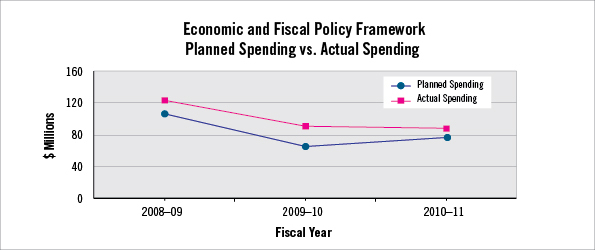
The Economic and Fiscal Policy Framework program activity includes work associated with the establishment of a Canadian Securities Regulation regime and a Canadian Regulatory Authority as well as departmental operating expenditures and employee benefits. Planned spending varies from actual spending primarily because of additional spending authorities that are granted through the Supplementary Estimates process. In 2010–11, the Economic and Fiscal Policy Framework program activity received additional spending authorities through the Supplementary Estimates in the amount of $10 million for advertising and $2.4 million for the Task Force for the Review of the Payment System.
Actual spending in 2010–11 decreased by $2.7 million compared to 2009–10. There was a decrease in operating expenditures and employee benefit plans of $10.6 million, offset by an increase in statutory expenditures of $7.9 million for the Canadian Securities Transition Office.
The decrease of $31.9 million in actual spending from 2008–09 to 2009–10 was attributable to the separate reporting of the Internal Services program activity starting in 2009–10. Prior to 2009–10, Internal Services were reported as part of the Economic and Fiscal Policy Framework program activity.
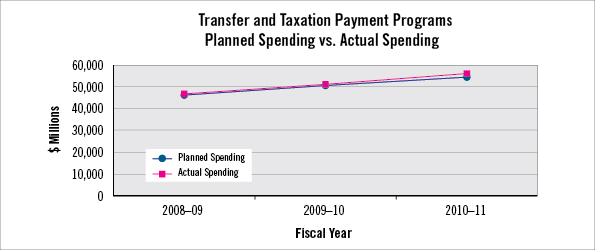
* Most spending in this program activity relates to transfer payments from the federal government to other levels of government.
The Transfer and Taxation Payment Programs program activity administers transfer and taxation payments to the provinces and territories, taxation payments to Aboriginal governments, transfers to international financial institutions for the purposes of debt relief, and financial and technical assistance to developing countries.
In 2010–11, actual spending for the Transfer and Taxation Payment Programs program activity increased by $5.1 billion, from $51.2 billion in 2009–10 to $56.3 billion in 2010–11. Payments to Ontario and British Columbia related to the harmonized sales tax framework made up $3.5 billion of this increase. The remainder can be explained by increases in transfer payments for the Canada Health Transfer, the Canada Social Transfer, Fiscal Equalization, and Territorial Formula Financing, which have increased according to legislation. The Canada Health Transfer has grown by 6 per cent annually, and the Canada Social Transfer by 3 per cent annually. Territorial Formula Financing has grown in line with its legislated funding framework, and the Equalization program has increased in line with the economy.
The increase of $3 billion in actual spending from 2008–09 to 2009–10 was attributable to increases in statutory programs.
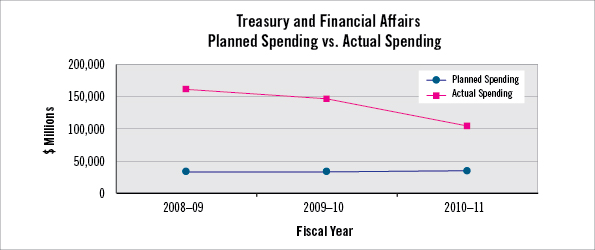
The Treasury and Financial Affairs program activity includes loans to Crown corporations, interest and other costs related to the public debt, and expenditures related to domestic coinage.
Planned spending in 2010–11 did not include $76.4 billion related to gross borrowing requirements of Crown corporations. The government announced in Budget 2007 that it would meet all of the domestic borrowing needs of Farm Credit Canada, the Business Development Bank of Canada, and the Canada Mortgage and Housing Corporation through direct lending in order to reduce overall borrowing and improve the liquidity of the government securities market.
In 2010–11, actual spending for the Treasury and Financial Affairs program activity decreased by $42.5 billion, from $147.0 billion in 2009–10 to $104.5 billion in 2010–11. This decrease is a result of a decrease in the gross borrowing requirements ($43.2 billion) of Farm Credit Canada, the Business Development Bank of Canada, and the Canada Mortgage and Housing Corporation. This decrease was offset by an increase of $0.7 billion in interest and other costs related to an increase in public debt levels.
The decrease of $15 billion in actual spending from 2008–09 to 2009–10 was attributable to a $12 billion decrease in the gross borrowing requirements of Farm Credit Canada, the Business Development Bank of Canada, and the Canada Mortgage and Housing Corporation, while the remaining $3 billion decrease was attributable to reduced interest and other costs resulting from a significantly reduced interest rate environment in 2009–10.
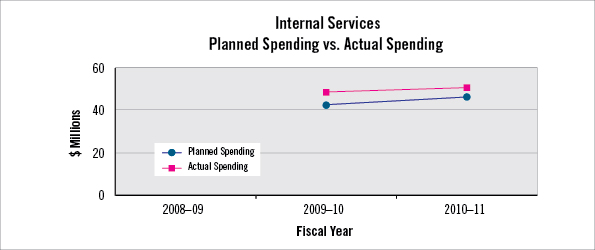
The Internal Services program activity involves activities and resources that support program activities of the Department. Prior to 2009–10, Internal Services spending was presented as part of the Economic and Fiscal Policy Framework program activity.
In 2010–11, actual spending for the Internal Services program activity increased by $1.9 million, from $48.6 million in 2009–10 to $50.5 million 2010–11. This increase was in support of other program activities within the Department.
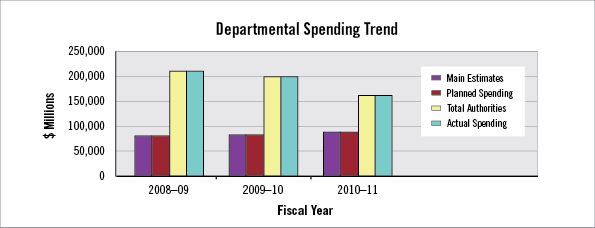
Canada's Economic Action Plan (CEAP)
A key priority during 2010–11 was the continued effective and timely implementation of Canada's Economic Action Plan, including reporting on progress. The Economic Action Plan, announced in Budget 2009, is a $60-billion plan to protect and create jobs in response to the deepest global recession since the Second World War.
In its first year of implementation, 2009–10, close to $32 billion in support was provided to individuals and businesses affected by the economic downturn. Approximately $25 billion in additional support for the recovery was delivered in 2010–11. Investments made through the Economic Action Plan have provided significant support to jobs and growth and have helped promote economic stability for Canadians during the worst of the global recession. As of March 2011, more than 28,500 Economic Action Plan projects were underway across Canada or had been completed.
The Department of Finance has coordinated with other central agencies and departments to ensure the speedy and efficient delivery of resources allocated under the Economic Action Plan. The Department has continued to monitor, assess and report on the progress of the Action Plan's stimulus measures. In 2010–11, in consultation with other federal departments responsible for implementing the Action Plan, the Department prepared and published the Sixth and Seventh Reports to Canadians on the Economic Action Plan in September 2010 and January 2011, respectively. These reports also included an analysis of the impact of these stimulus measures on the Canadian economy. In the 2010 Fall Report of the Auditor General of Canada, it was noted that the selected EAP programs that were audited had been adequately managed by putting in place appropriate management practices and by providing programs to eligible recipients in a timely manner.[1]
In 2010–11, the Department of Finance Canada received funding of $2.8 million as part of Canada's Economic Action Plan.
The Reports to Canadians on Canada's Economic Action Plan can be found at www.actionplan.gc.ca.
Estimates by Vote
For information on the Department of Finance Canada's organizational Votes and/or statutory expenditures, please see the Public Accounts of Canada 2010 (Volume II) publication. An electronic version of the Public Accounts is available on the Public Works and Government Services Canada website.[2]
